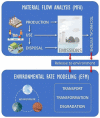Environmental Impact of Nanoparticles' Application as an Emerging Technology: A Review
- PMID: 33396469
- PMCID: PMC7795427
- DOI: 10.3390/ma14010166
Environmental Impact of Nanoparticles' Application as an Emerging Technology: A Review
Erratum in
-
Erratum: Guillermo M., et al. Environmental Impact of Nanoparticles' Application as an Emerging Technology: A Review. Materials 2021, 14, 166.Materials (Basel). 2021 Mar 31;14(7):1710. doi: 10.3390/ma14071710. Materials (Basel). 2021. PMID: 33807498 Free PMC article.
Abstract
The unique properties that nanoparticles exhibit, due to their small size, are the principal reason for their numerous applications, but at the same time, this might be a massive menace to the environment. The number of studies that assess the possible ecotoxicity of nanomaterials has been increasing over the last decade to determine if, despite the positive aspects, they should be considered a potential health risk. To evaluate their potential toxicity, models are used in all types of organisms, from unicellular bacteria to complex animal species. In order to better understand the environmental consequences of nanotechnology, this literature review aims to describe and classify nanoparticles, evaluating their life cycle, their environmental releasing capacity and the type of impact, particularly on living beings, highlighting the need to develop more severe and detailed legislation. Due to their diversity, nanoparticles will be discussed in generic terms focusing on the impact of a great variety of them, highlighting the most interesting ones for the industry.
Keywords: green chemistry; nanomaterial release models; nanoparticles’ emission; nanotechnology; negative impact; positive impact; toxicity.
Conflict of interest statement
The authors declare no conflict of interest.
Figures






References
Publication types
Grants and funding
LinkOut - more resources
Full Text Sources

